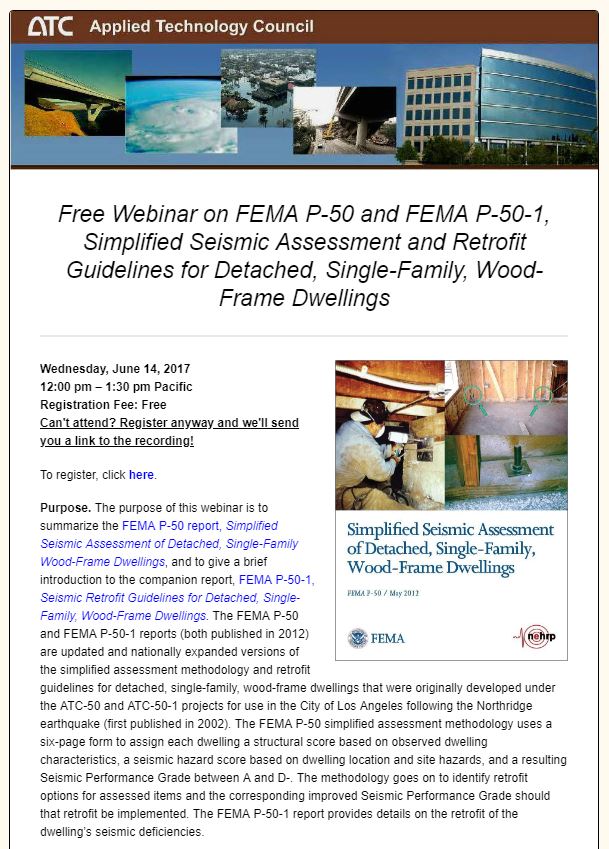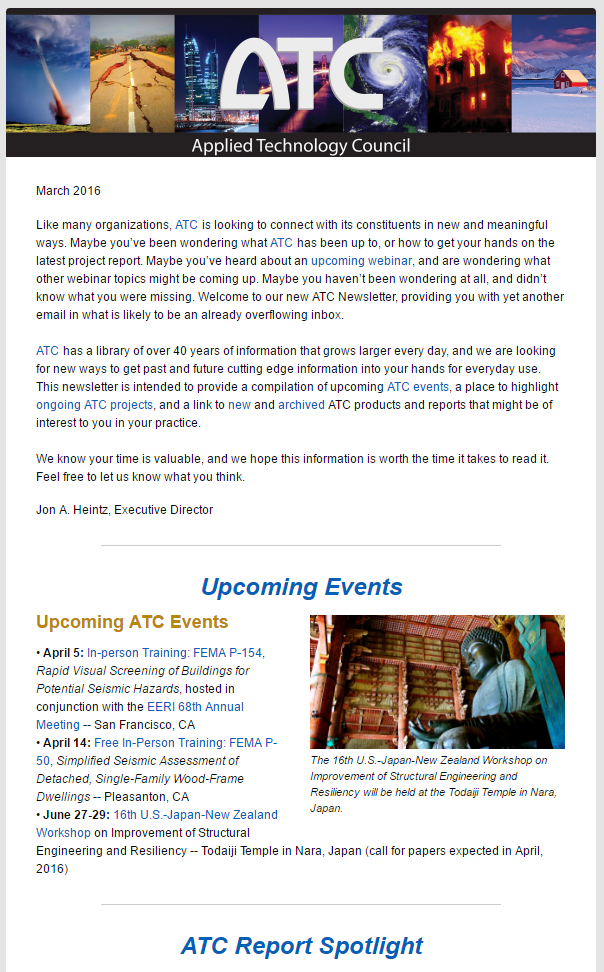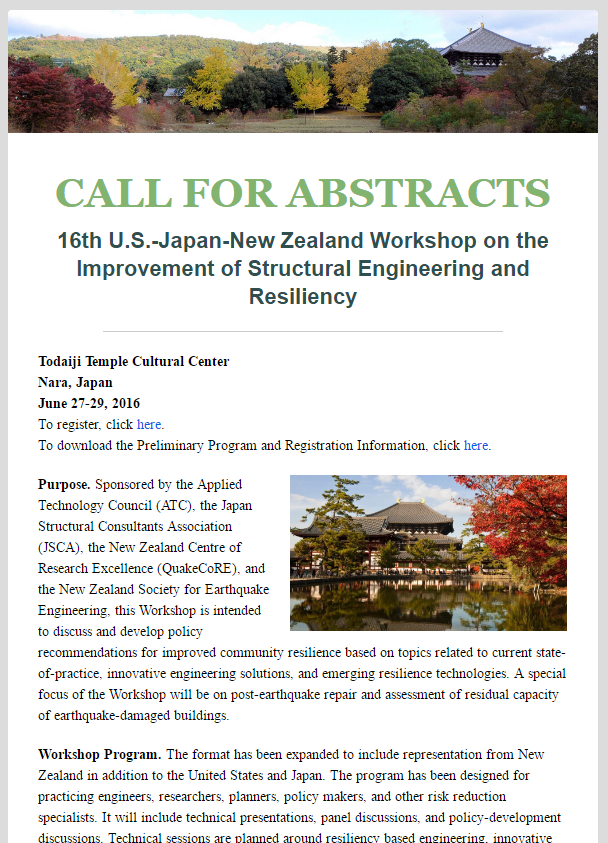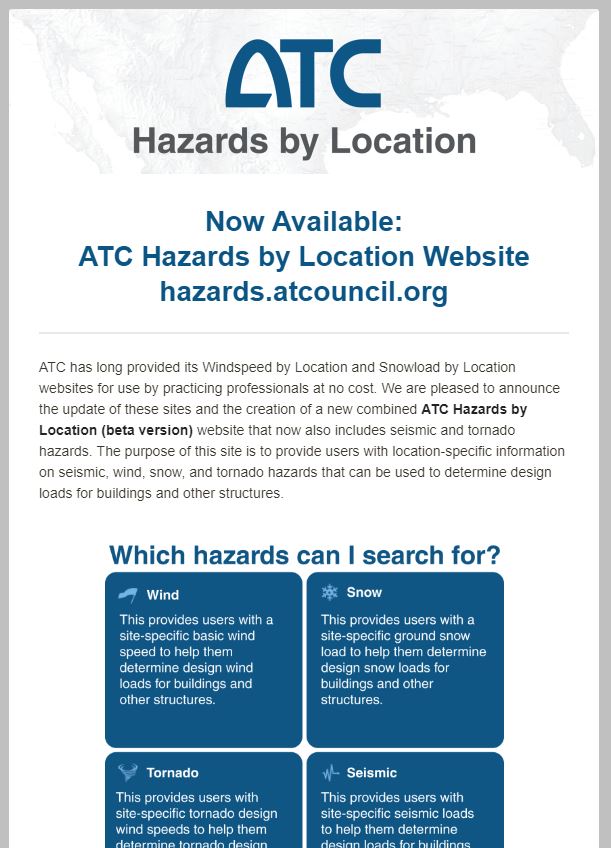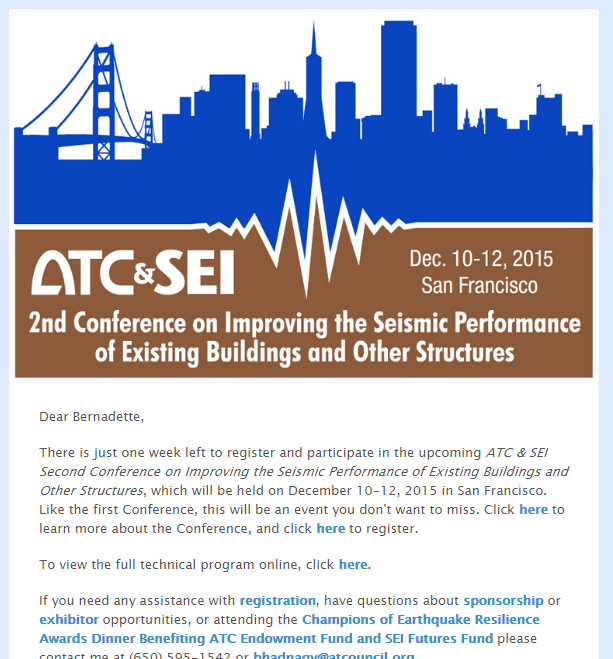ATC Special Session at the 16th World Conferenc e
e
on Earthquake Engineering
The Applied Technology Council has organized a special session at the 16th World Conference on Earthquake Engineering. This webpage presents the paper abstracts and related documents available through ATC.
If you have any questions regarding the presentations, please This email address is being protected from spambots. You need JavaScript enabled to view it..
SESSION 22SS: Emerging and Newly Available Tools, Guidance, and Proposed Applications for Seismic Hazard Mitigation
Thursday January 12, 2017
10:30am – 12:30 pm
Cordillera III Room
Organizers: Ayse Hortacsu (ATC), Michael Mahoney (FEMA), Siamak Sattar (NIST)
Moderators: Siamak Sattar (NIST), Jon Heintz (ATC)
Papers will be presented in the following order:
1. Improvements in Postearthquake Building Safety Evaluations: Lessons Learned from Recent Earthquakes
2. Building and Nonstructural Component Performance in the 2014 South Napa Earthquake
3. Simplified Seismic Evaluation of Older Concrete Buildings for Collapse Potential (ATC-78)
4. ATC-92: Comparison of U.S. and Chilean Building Code Requirements and Seismic Design Practice 1985–2010
5. Addressing Boundary Design for Reinforced Concrete Walls, Based on Studies of the 2010 Chile Earthquake
6. The ATC-58-2 Project Further Development of Next Generation Performance-based Design Criteria
7. Future Developments in the Seismic Analysis and Design of Nonstructural Components for Buildings
8. Community Resilience of Lifeline Systems: Societal Needs and Performance Assessment
For more information on each paper, please read below.
1. Improvements in Postearthquake Building Safety Evaluations: Lessons Learned from Recent Earthquakes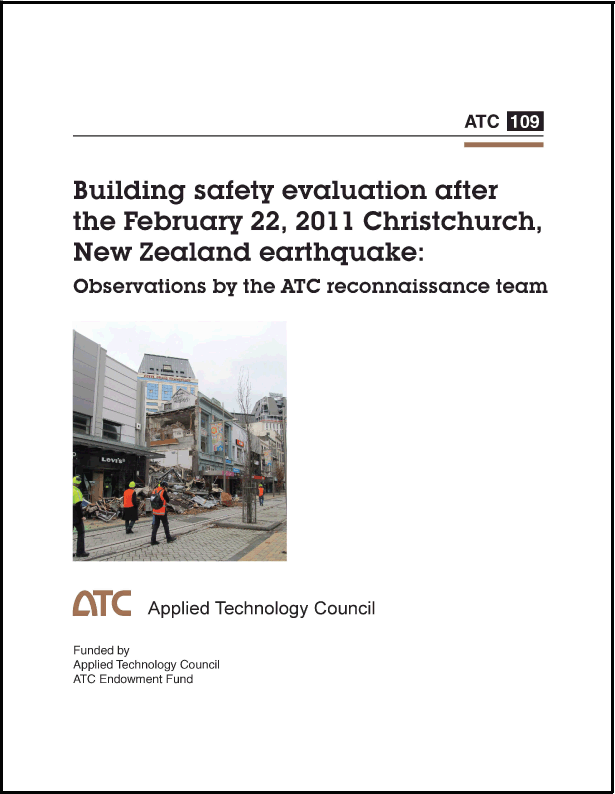
Authors: B. Lizundia, A. Hortacsu, R. Gallagher
Presenter: A. Hortacsu
Paper No: 2275
The ATC-20 report, Procedures for Postearthquake Safety Evaluation of Buildings, was published by the Applied Technology Council in 1989 specifically for use by qualified professionals who would be required to make on-the-spot evaluations and decisions regarding continued use and occupancy of damaged buildings. Since 1989, the ATC-20 methodology has been used worldwide in response to earthquakes of varying magnitudes, and a family of ATC-20 documents has been developed, including a second edition of a field manual (ATC-20-1) in 2005.
This paper will reflect on lessons learned during recent development exercises, such as the development of an adaptation of the ATC-20-1 methodology for Bhutan which considered the country’s vernacular buildings, made adjustments for its cultural and governmental context, and provided an extensive set of images of varying degrees and types of building damage with the recommended posting category. The paper will also summarize and synthesize lessons learned from postearthquake safety evaluations conducted after recent damaging earthquakes, such as 2010 in Chile, 2011 in New Zealand, 2014 in Napa, California, and 2015 in Nepal. The original ATC-20 methodology has been adapted to other structural and governmental contexts, including documents funded by the local governments of New Zealand and Nepal. Each of these adaptations offered enhancements to the existing methodology and utilized different methods of communication. This paper will present a best practices overview from observed modifications.
For example, following the magnitude-6.2 22 February 2011 Christchurch, New Zealand earthquake, local officials, despite being initially caught off guard and unprepared for the scope and severity of the damage, made over 72,000 building inspections in 10 days. Many useful practices were instituted, including an emphasis on shelter-in-place, the addition of usability categories to placards, use of indicator buildings to help determine if reinspections after major aftershocks were warranted, and the forming of specialized teams to deal with specific concerns (such as buildings in danger of collapse). The approach taken by the New Zealand government in assessing buildings in Christchurch and subsequent modifications they made to their approach presents a major opportunity to learn from the experience, and this paper will present how this information can be used to update and improve the ATC-20 procedures.
In Nepal, a variety of postearthquake evaluation practices were observed, with extensive volunteer efforts both by engineers from Nepal and from many other countries. Nepal’s guidelines include photographs of damaged buildings consistent with Nepal’s building stock with the damage clearly linked to the recommended placarding categories of INSPECTED, RESTRICTED USE, and UNSAFE.
The ATC-109 report, Building Safety Evaluation after the February 22, 2011 Christchurch, New Zealand Earthquake: Observations by the ATC Reconnaissance Team, was funded by the Applied Technology Council Endowment Fund. To obtain a copy of this report, please visit the ATC online store.
The ATC-20-1, Field Manual: Postearthquake Safety Evaluation of Buildings (Second Edition), and related documents, including the ATC-20-1 Bhutan Field Manual, can be obtained through the ATC online store.
2. Building and Nonstructural Component Performance in the 2014 South Napa Earthquake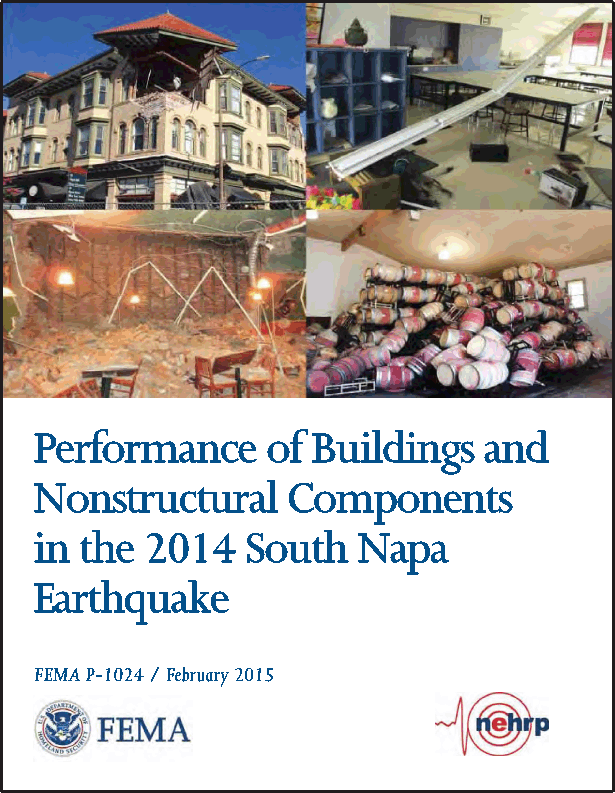
Authors: A. Hortacsu, M. Phipps, J. Gillengerten, M. Mahoney
Presenter: A. Hortacsu
Paper No: 1343
It is common to focus post-earthquake reconnaissance on observations of damage rather than performance, both bad and good. Without systematically collecting and analyzing data, it is not possible to correlate the relationships between ground shaking severity and the performance of buildings. On August 24, 2014, a magnitude-6.0 earthquake struck northern California. The epicenter was located 9 km (6 miles) south southwest of the city of Napa, which was significantly impacted by the event. The peak recorded horizontal ground accelerations in Napa were as high as approximately 0.6 g. This earthquake provided an excellent opportunity to evaluate and calibrate existing earthquake hazard reduction methodologies and to expand existing knowledge and databases on the performance of buildings and other structures. The Federal Emergency Management Agency (FEMA) contracted with the Applied Technology Council (ATC) to document the performance of buildings in the earthquake. The focus of this investigation was the collection of data to comprehensively examine the nature and scope of building performance in the earthquake. The investigation centered on a ground motion instrument located in downtown Napa, and included every building within 1,000 feet, whether it was damaged or not. Many of the buildings investigated are unreinforced masonry (URM) construction, and a significant number of these had already been seismically retrofitted. This provided a unique opportunity to explore the effectiveness of seismic hazard mitigation efforts, and develop recommendations to further improve mitigation. The performance of buildings designed in accordance with more recent building codes, including healthcare and school facilities, residential construction, manufactured housing, and the performance of nonstructural components and systems were also investigated. The earthquake had a significant impact on the world famous wineries around Napa, and the performance of these facilities is also discussed. The Napa Valley has approximately 400 wine production facilities, and estimated 50 wineries were exposed to significant seismic ground shaking and sustained measurable damage to tanks, barrels and/or buildings. The paper will also provide an update on the status of some of the more significant building repairs one year later.
You can download the FEMA P-1024 report, Performance of Buildings and Nonstructural Components in the 2014 South Napa Earthquake, and the accompanying Recovery Advisories (Chimneys and Cripple Walls) from the ATC-125 project webpage.
Click the following links to download the FEMA P-50 report, Simplified Seismic Assessment of Detached, Single-Family, Wood-Frame Dwellings, and its companion FEMA P-50-1 report, Seismic Retrofit Guidelines for Detached, Single-Family, Wood-Frame Dwellings.
3. Simplified Seismic Evaluation of Older Concrete Buildings for Collapse Potential (ATC-78)
Authors: A.B. Liel, W. Holmes, M. Mehrain, J. Moehle, P. Somers
Presenter: Travis Marcilla
Paper No: 1166
The seismic life safety risk from older concrete buildings, particularly frame buildings, is well known. Existing evaluation methods – which are based on component performance – are reasonable to assess damage potential, but are generally judged to be too conservative to predict collapse and significant risks to life safety. For several years, the Federal Emergency Management Agency or FEMA, through ATC, has sponsored the development of a simplified method to estimate the probability of collapse that can be used to rank older concrete buildings for the purpose of identifying the truly dangerous ones. It is expected that such a method would be applied to a significant inventory of buildings in a screening phase of risk mitigation, so the level of engineering effort must be minimized. The method developed includes estimation of an approximate period and tabular approaches to estimate drift distributions at each story based on relative strengths and strength ratios of vertical and horizontal structural elements and presence of walls. For buildings where columns govern collapse, drift demand is compared with plastic rotation capacity for each column and a column rating related to the probability of loss of vertical load capacity is determined. The ratings of columns in the critical story are then statistically combined to estimate a probability of story collapse at that story. In contrast to conventional component-based methodologies, a probability of complete story collapse is thus deduced and the collapse probability depends on the condition of the combination of components. The method has been developed targeted at U. S. building types and covers gravity frames with or without lateral force design, slab-column frames and frame buildings with walls. Procedures for bearing wall buildings are in progress. Structures are limited to 13 stories, but can have both horizontal and vertical irregularities. Trial evaluations have been carried out for frame structures to compare this methodology to other procedures for seismic assessment of these buildings and assess the difficulty of carrying out the assessment.
More information on the ATC-78 project series can be found on the ATC-78 Project Series webpage.
4. ATC-92: Comparison of U.S. and Chilean Building Code Requirements and Seismic Design Practice 1985–2010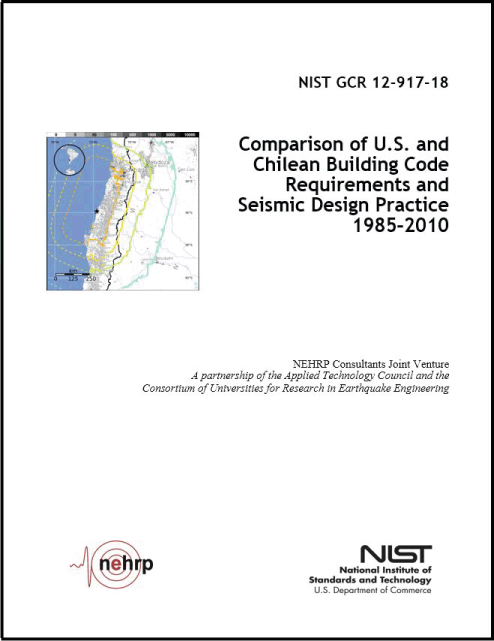
Authors: J.A. Heintz, R.O. Hamburger, P. Bonelli, R. Lagos, L.A. Wyllie, Jr.
Presenter: J. Heintz
Paper No: 2279
As a result of the February 27, 2010, magnitude 8.8 Maule earthquake that occurred off the coast of central Chile, the National Institute of Standards and Technology (NIST) funded a series of projects to investigate the performance of buildings and other structures affected by the earthquake. In the time leading up to the 2010 Maule earthquake, many U.S. design concepts were embodied in Chilean seismic design practice in NCh433.Of96, Earthquake Resistant Design of Buildings, and NCh430.Of2008, Reinforced Concrete Design and Analysis Requirements. As a result, the 2010 Maule earthquake represented a unique opportunity to study the behavior of modern engineered reinforced concrete construction, similar to that present in the United States, in response to strong ground shaking.
In order to draw linkages between observed performance in Chile and implications for U.S. practice, an understanding of the similarities and differences between U.S. and Chilean seismic design philosophies was needed. The ATC-92 Project was funded to: (1) document building code requirements and design and construction practices in effect in Chile during the period 1985–2010; and (2) compare and document observed differences between operative codes and seismic design practices in Chile and the United States. The resulting NIST GCR 11-917-18 report, Comparison of U.S. and Chilean Building Code Requirements and Seismic Design Practice 1985-2010, presents a side-by-side comparison of design requirements in the United States and Chile, identifies similarities, and contrasts differences. It also provides an illustrative comparison of design practice through an evaluation of both Chilean and U.S. design provisions applied to a typical Chilean building configuration.
5. Addressing Boundary Design for Reinforced Concrete Walls, Based on Studies of the 2010 Chile Earthquake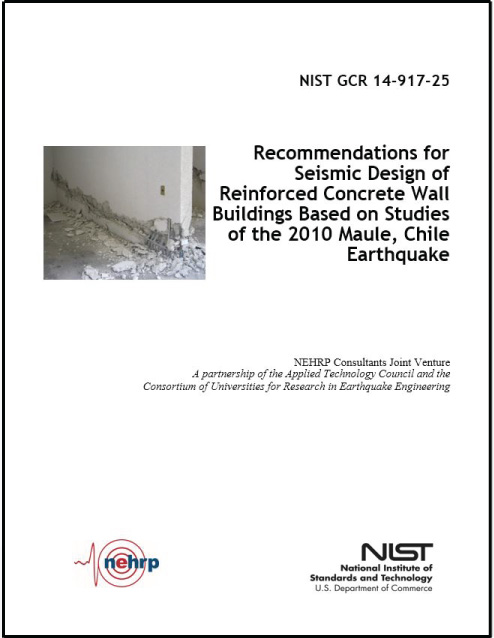
Authors: K. Telleen, J. Maffei, J. Heintz, P. Bonelli, D. Kelly, M. Willford
Presenter: J. Maffei
Paper No: 2384
The 2010 Maule Chile Earthquake caused damage to several mid-rise and high-rise concrete wall buildings. Based on observations by reconnaissance teams and similarities between U.S. and Chilean seismic design and construction practices, the National Institute of Standards and Technology recognized the unique opportunity to investigate the observed performance of buildings subjected to strong ground shaking, and to identify lessons for improving design and construction of reinforced concrete buildings.
The project was conducted by the Applied Technology Council (ATC‑94 project) with participation from engineers and researchers from the United States and Chile. Project objectives are to: (1) evaluate critical issues in the design of reinforced concrete walls; and (2) develop recommendations for improving wall design requirements. Findings include:
- Unintended coupling of walls can cause damage to coupling elements (such as slabs and beams) or to the coupled walls. The type of damage to walls varies, depending on demands and reinforcement. Some types of damage to walls are described below.
- Buckling of longitudinal (vertical) reinforcement is influenced by tension strain. Bar buckling can occur throughout the wall cross-section, not just at the ends. In plastic hinge regions, the extent of “buckling-restraint” ties should consider the tensile strain demand throughout the cross-section, not just compression neutral axis depth. In other words, “bucking-restraint” ties may be needed over a greater length of wall than the length of ACI 318 “special boundary elements,” which is related to compression.
- Damage typically occurred in walls that had few or no hoops or cross-ties, where special boundary elements would have been required in accordance with ACI 318. Providing cross-ties to prevent bar buckling would improve performance in some cases. Providing greater area of concrete (thicker walls) and hoops and cross-ties meeting the spacing and area requirements of “special boundary elements” would further improve performance in cases with high compression demand.
- While overall wall buckling was at first thought to be a more prevalent issue in Chile based on post-earthquake reconnaissance, studies of selected buildings suggest that other behaviors, such as bar buckling and concrete crushing, initiated much of the damage initially considered as wall buckling. Nonetheless, in plastic hinge regions, it is recommended to provide a minimum wall thickness at the ends of the wall, such as 1/16 or more of the unsupported wall height, similar to requirements of the 1997 UBC and as was adopted for boundary elements in ACI 318-14.
- One type of configuration that was associated with damage in the Chile earthquake is a solid wall below (or above) a series of vertically-aligned openings. Another such configuration is a “flag-shaped” wall, where the length of wall is reduced at the lower stories compared to the upper stories.
- Pier-spandrel systems in which the spandrels are stronger than piers can contribute to damage and story mechanisms. Current requirements of ACI 318 have provisions to encourage strong-column weak-beam behavior in moment frames, but similar requirements do not exist for pier-spandrels systems. Capacity design for strong-pier weak-spandrel behavior would improve performance of such systems.
The ATC-94 project produced the NIST GCR 14-917-25 report, Recommendations for Seismic Design of Reinforced Concrete Wall Buildings Based on Studies of the 2010 Maule, Chile Earthquake.
6. The ATC-58-2 Project Further Development of Next Generation Performance-based Design Criteria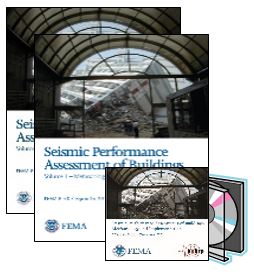
Authors: R.O. Hamburger, J.D. Hooper, John D. Gillengerten, Laura Dwelley-Samant, Jon Heintz, M. Mahoney
Presenter: R.O. Hamburger
Paper No: 1131
In 2012, the Applied Technology Council (ATC) completed the first phase of its ATC-58 Project with publication of the FEMA P-58 Next-Generation Seismic Performance Assessment Methodology. Shortly thereafter, ATC initiated work on a second Project phase intended to enable practical implementation of the methodology on seismic design and retrofitting projects. Major enhancements include improvement of the fragility library; calibration and benchmarking of results against actual building performance in earthquakes; development of simplified design aides to enable practical use in design; implementation of an environmental consequences module, cooperation with private software developers to allow enhancement of available applications software; and, outreach to stakeholders and decision makers to understand how the methodology can best be used to address their needs. Significant improvements to usability and usefulness have resulted.
Information about this project is available on the ATC-58 Project Series webpage.
7. Future Developments in the Seismic Analysis and Design of Nonstructural Components for Buildings
Authors: M. Phipps, S. Fathali, J. Gillengerten, T. Hutchinson, R. Medina, R. Bachman, M. Hoehler, S. Schiff, J, Heintz
Presenter: M. Phipps
Paper No.: 2304
Damage to nonstructural components has accounted for the majority of earthquake losses in recent earthquakes, especially in the United States and Chile. This damage primarily occurred to nonstructural components located within buildings. The current procedures for seismic design of nonstructural components were first introduced in the 1994 edition of the National Earthquake Hazards Reduction Program (NEHRP) Recommended Provisions for Seismic Regulations for New Buildings with the intention of lessening this damage. The procedures were subsequently incorporated into the 1997 edition of the Uniform Building Code and into the 2000 edition of the International Building Code and provided a substantial improvement in seismic design practice. Many new concepts, new to the building codes, were introduced, including consideration of dynamic properties of the component, location of the component within the supporting structure, and explicit attention to the relative importance of the component and component ductility. The nonstructural concepts developed in the 1994 NEHRP Recommended Provisions have been in use for over two decades, and since 1995 have been incorporated in the American Society of Civil Engineers (ASCE) Structural Engineering Institute (SEI) ASCE/SEI 7, Minimum Design Loads for Buildings and Other Structures. Because of the timing and epicenter locations of recent earthquakes, nonstructural components designed and installed to satisfy these current seismic design procedures have not yet been subjected to significant damaging earthquakes.
In 2013, the National Institute of Science and Technology (NIST) published GCR 13-917-23, Development of NIST Measurement Science R&D Roadmap: Earthquake Risk Reduction in Buildings. This document identified nonstructural issues as a top-priority for studies related to earthquake engineering for new and existing buildings. New research tools and analysis results as well the availability of new international standards, makes reexamination of nonstructural design criteria possible at this time. Accordingly, NIST initiated the ATC-120 project with the Applied Technology Council (ATC) in late 2014. The goal of this project is to improve technical aspects of nonstructural system design in the areas that will have the largest impact for public safety and economic welfare with an emphasis on determining whether or not a disconnect exists between current design requirements and observed (or expected) performance of nonstructural building systems and components. Where significant gaps are identified, technical solutions are proposed. The project is being conducted in two phases. In the first phase, knowledge studies were performed looking at both the literature and the current state of practice. The goal of the first phase was to understand performance criteria objectives and measures and to prioritize potential areas for further study. In the second phase, focused studies are performed on the priority areas identified in the first phase.
Summaries of the recently completed ATC-120 project knowledge study and workshop are presented. Recommendations for improving seismic analysis and design of nonstructural components and systems (NCSs) are discussed.
8. Community Resilience of Lifeline Systems: Societal Needs and Performance Assessment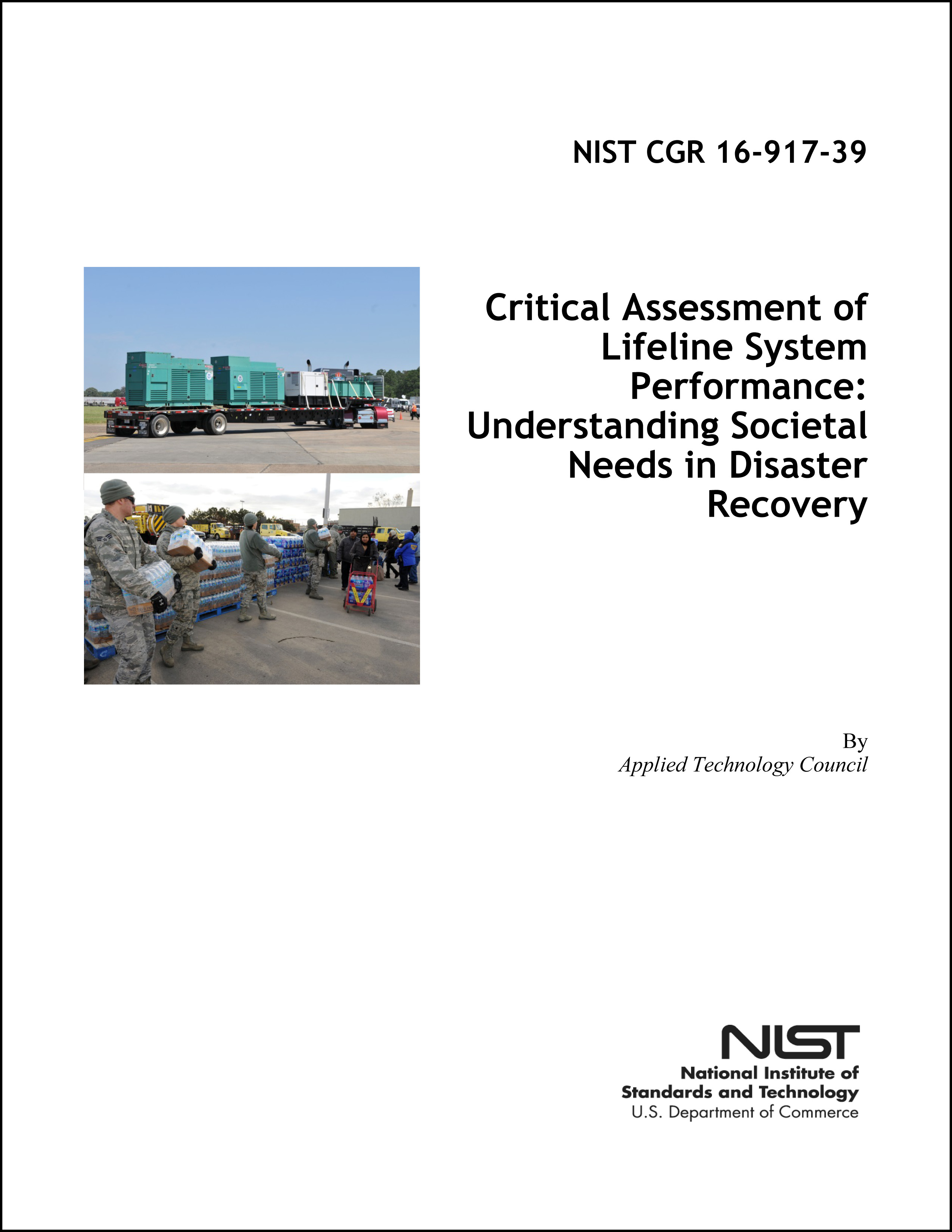
Authors: C. Rojahn, L. Johnson, T. D. O’Rourke, V. Cedillos, T. P. McAllister, S. L. McCabe
Presenter: V. Cedillos
Paper No: 2686
The concept of community resilience is a complex, multi-dimensional problem that relies on social science, engineering, earth sciences, economics, and other disciplines to improve the way communities prepare for, resist, respond to, and recover from disruptive events. Community resilience can break the cycle of destruction and recovery and reduce the impacts of earthquakes and other hazards. This requires community planning for recovery of function and setting of recovery goals prior to the occurrence of hazard events to minimize social and economic disruptions.
Investigations of lifeline system performance, interdependencies, and corresponding impacts on communities following earthquakes and other disasters around the world have highlighted the need for a new approach to improve the earthquake resilience of lifelines. In 2013, the National Institute of Standards and Technology (NIST) funded a project, led by the Applied Technology Council (ATC), that resulted in the NIST GCR 14-917-33 report, Earthquake Resilient Lifelines: NEHRP Research, Development, and Implementation Roadmap. This report identified the need for assessing societal expectations of acceptable lifeline performance levels and recovery times at the community level as a high-priority research and development topic.
NIST funded a follow-on project in 2014 led by ATC to assess current societal expectations of acceptable lifeline performance levels and recovery timeframes, distinguishing those that are hazard independent and those that are specific to earthquakes (including tsunami), as well as other natural hazard events (ATC-126 Project). The team developed the NIST GCR 16-917-39 report, Critical Assessment of Lifeline System Performance: Understanding Societal Needs in Disaster Recovery, which focuses on societal needs and interdependencies of six key lifelines: electric power, gas and liquid fuel, water, wastewater, telecommunications, and transportation networks.
The NIST GCR 16-917-39 report identifies important gaps between expected lifeline system performance and the performance required to support adequately societal needs during and after a hazard event. Gaps were identified through an evaluation of performance and societal impacts during past events, as well as the assessment of key guidelines, standards and performance criteria that govern and shape the design, construction, operation and management of lifeline systems. The report identifies and discusses the social institutions and societal needs that should drive lifeline system performance levels and timeframes for recovery of function. Critical interdependencies, recommendations and needs particular to policy, modeling, research, and future trends for social needs and lifeline systems are included in the report. This report supports larger efforts, such as the Community Resilience Program and National Earthquake Hazards Reduction Program (NEHRP) at NIST, intended to help communities and lifeline owners and operators achieve a more integrated and consistent approach to resilience. The findings from this report, summarized in this paper, are intended to inform resilience efforts in the United States and other countries.
 The 1989 Loma Prieta Earthquake caused damage throughout the Bay Area, highlighting the impact of local geology and soil conditions, the vulnerability of structures to strong ground shaking, the need for coordinated emergency response, and the challenges of recovery. Stanford University was greatly affected by the earthquake and provided a rich case study in repair, retrofit and setting seismic design criteria that would lead to a more resilient future. The rapid-fire combination of the 1989 Loma Prieta and 1994 Northridge Earthquakes stimulated widespread seismic hazard mapping, the expansion of the statewide network of strong motion recording stations, and the production of near real time shake maps and supporting data. Advanced research into the performance of new structural systems and historic materials, aided by the development of advanced computational methods has led to refined techniques for designing structures to perform in predictable ways.
The 1989 Loma Prieta Earthquake caused damage throughout the Bay Area, highlighting the impact of local geology and soil conditions, the vulnerability of structures to strong ground shaking, the need for coordinated emergency response, and the challenges of recovery. Stanford University was greatly affected by the earthquake and provided a rich case study in repair, retrofit and setting seismic design criteria that would lead to a more resilient future. The rapid-fire combination of the 1989 Loma Prieta and 1994 Northridge Earthquakes stimulated widespread seismic hazard mapping, the expansion of the statewide network of strong motion recording stations, and the production of near real time shake maps and supporting data. Advanced research into the performance of new structural systems and historic materials, aided by the development of advanced computational methods has led to refined techniques for designing structures to perform in predictable ways.


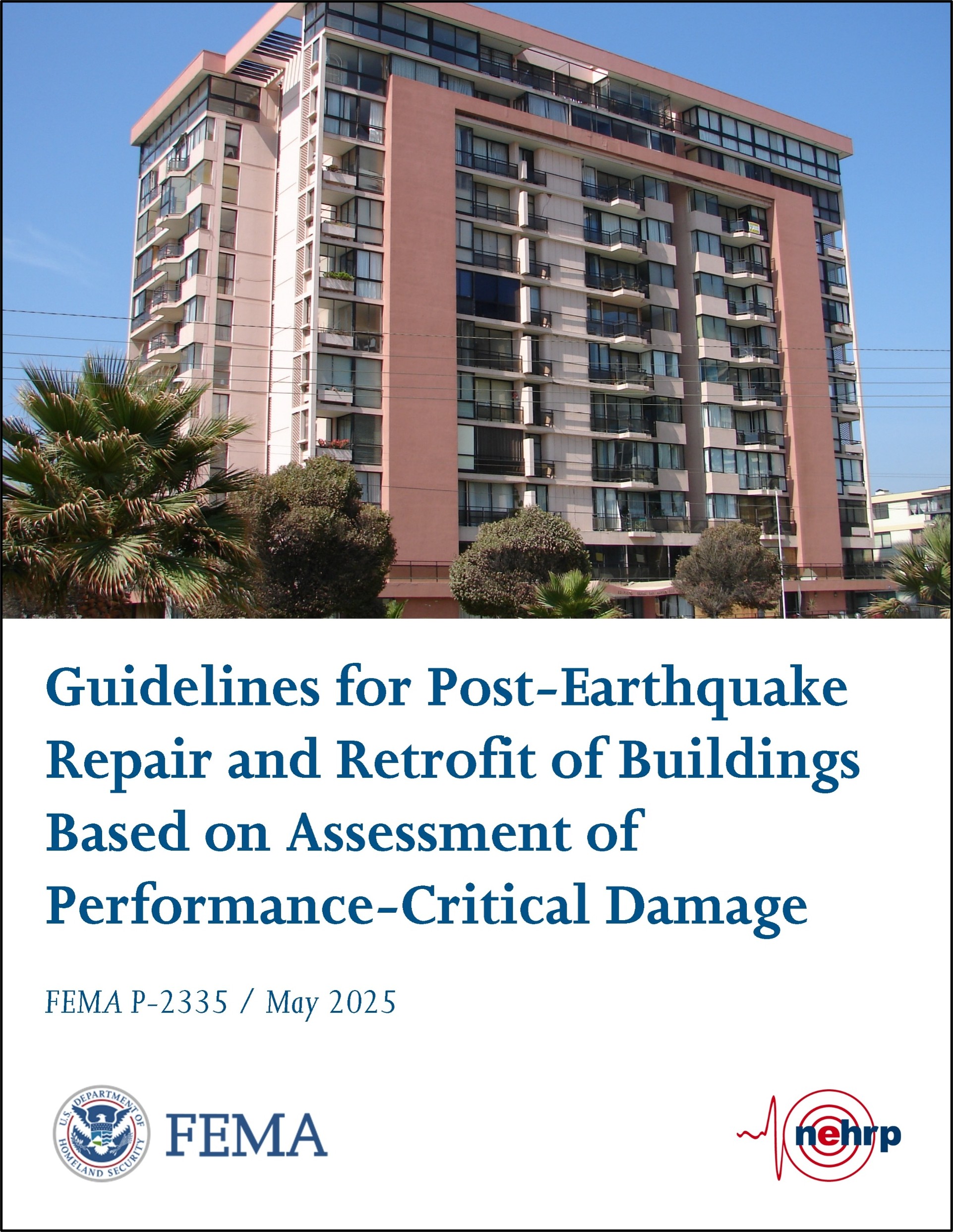

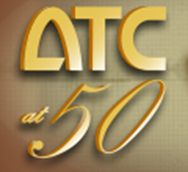

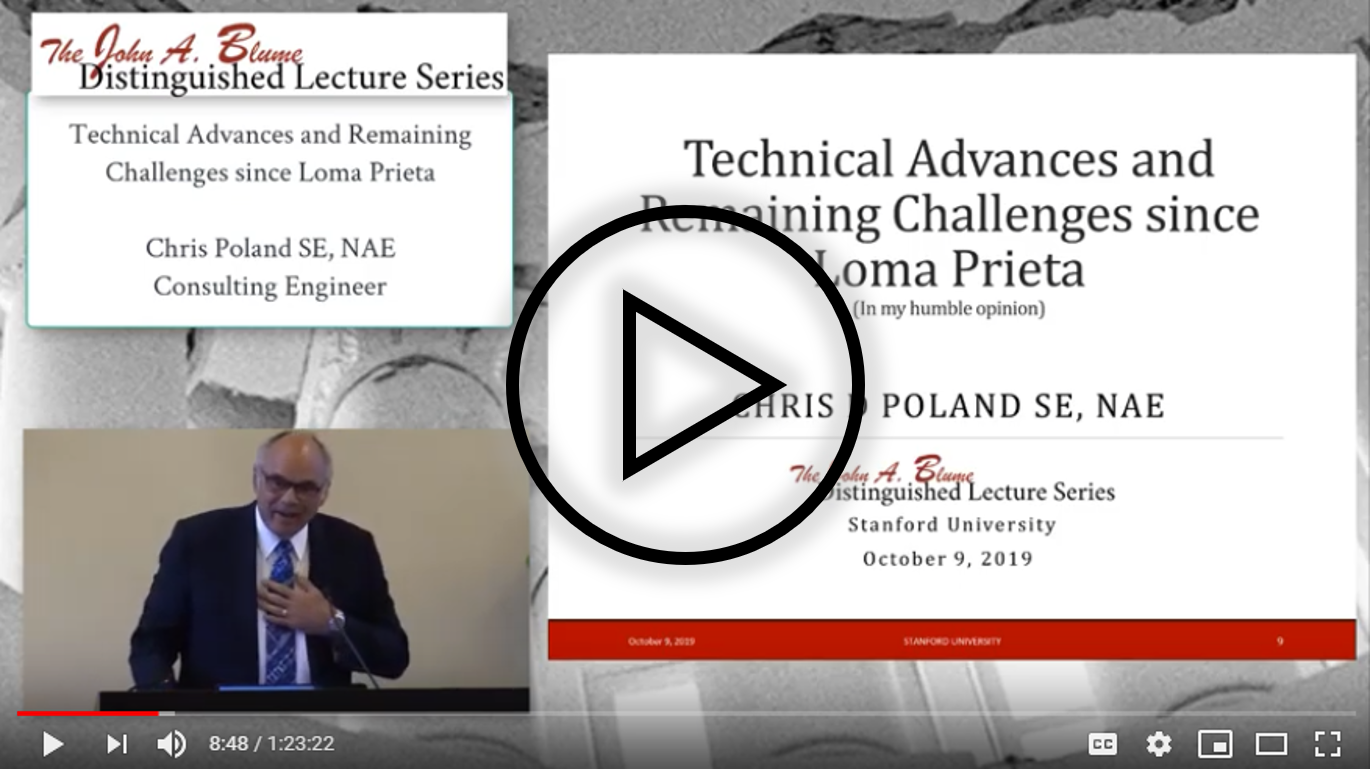
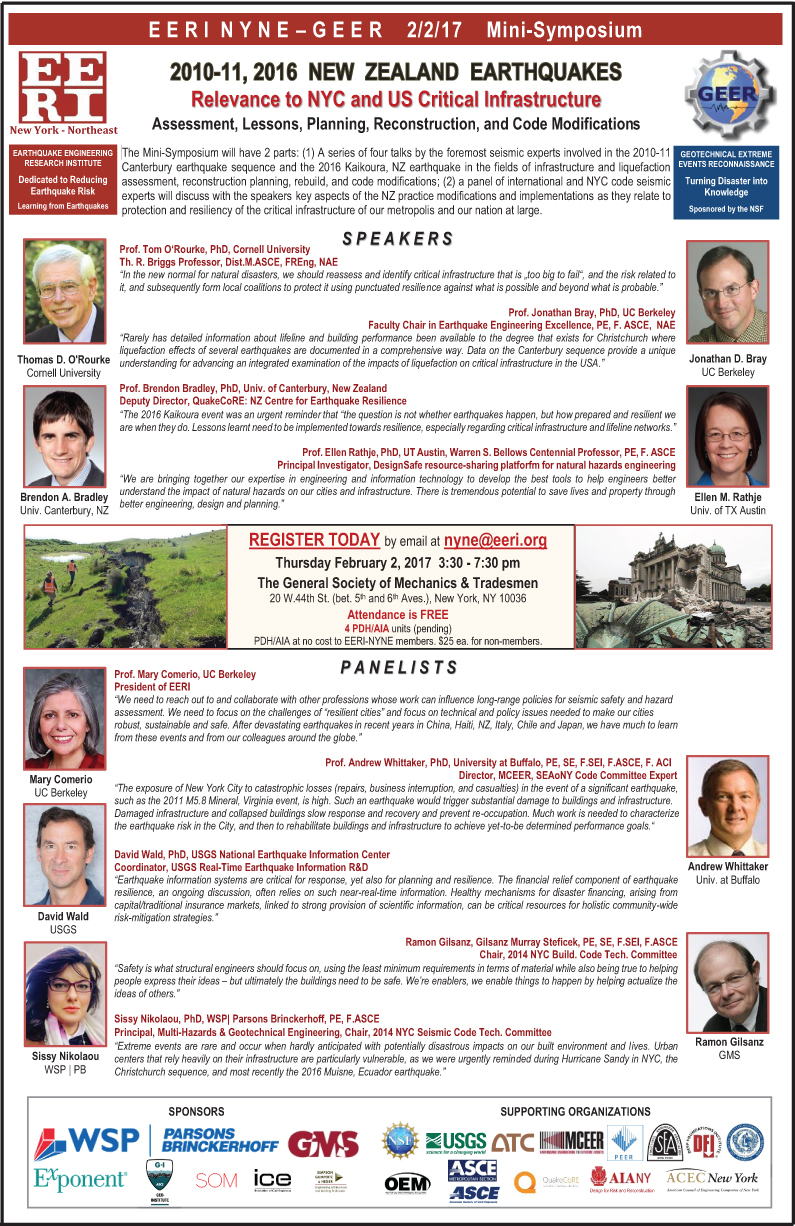
 * pending
* pending








